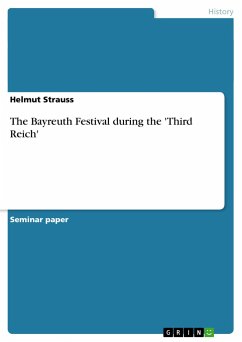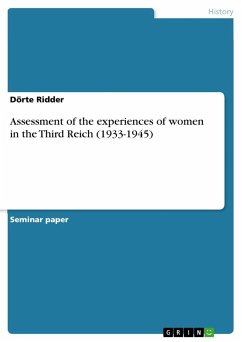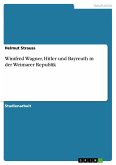Seminar paper from the year 2004 in the subject History Europe - Germany - National Socialism, World War II, grade: A (1,0), The New School (Historical Studies), course: Modern Dictatorship and Political Religion, language: English, abstract: [...]Since its founding in 1876, the Bayreuth Festival had been a locus of representation forpolitically prominent figures; among the guests of the first Festival were the German EmperorWilhelm I and the Brazilian Emperor Dom Pedro II2. In the years to come, Bayreuth wouldkeep its meaning as a "political symbol" 3.From 1933 on, the Wagnerian Hitler used the Festival for both the representation of hisperson and his regime. The Foundations for this appropriation were both ideological andpersonal:Firstly, after Richard Wagner's death, his "Bayreuth disciples" 4, grouped in the "BayreuthCircle" 5 especially Hans von Wolzogen and Houston Stewart Chamberlain6, created the "Bayreuth idea" 7; in this process of formulating their 'German Wagnerism' as a völkischideology, they focused more on Wagner's prose writings8, than on his music, and especiallyemphasized Wagner's anti-Semitism9.2 Eger, Manfred: Die Bayreuther Festspiele, in: Müller, Ulrich/Wapnewski, Peter (eds.): Richard-Wagner-Handbuch, Stuttgart 1986, p. 589-624, here: p. 596.3 Schmidt, Michael: Bayreuth als politisches Symbol. 125 Jahre Richard-Wagner-Festspiele, in: NeueGesellschaft. Frankfurter Hefte 48 (2001), p. 470-474.4 Large, David Clay: Wagner's Bayreuth Disciples, in: Large, David C. & Weber, William (eds.): Wagnerism inEuropean Culture and Politics, Ithaka and London 1984, p. 72-133.5 Schüler, Winfried: Der Bayreuther Kreis von seiner Entstehung bis zum Ausgang der Wilhelminischen Ära,Münster 1971.6 The English-born racial theoretician Chamberlain had from 1888 on contact with Wagner's widow Cosima; in1908, he married Eva Wagner, the daughter of Richard and Cosima and moved to Bayreuth; see Large, David Clay: Ein Spiegelbild des Meisters? Die Rassenlehre von Houston Stewart Chamberlain, in: Borchmeyer,Dieter/Maayani, Ami/Vill (eds.), Susanne: Richard Wagner und die Juden, Stuttgart &Weimar 2000., p. 140-159.7 Large, Disciples, op.cit., p.133.8 Large, Disciples, op.cit., p. 133.9 For a differentiated and instructive analysis of Wagner's anti-Semitism see Katz, Jacob: The Darker Side ogGenius. Richard Wagner's Anti-Semitism. Hanover & London, 1986.








